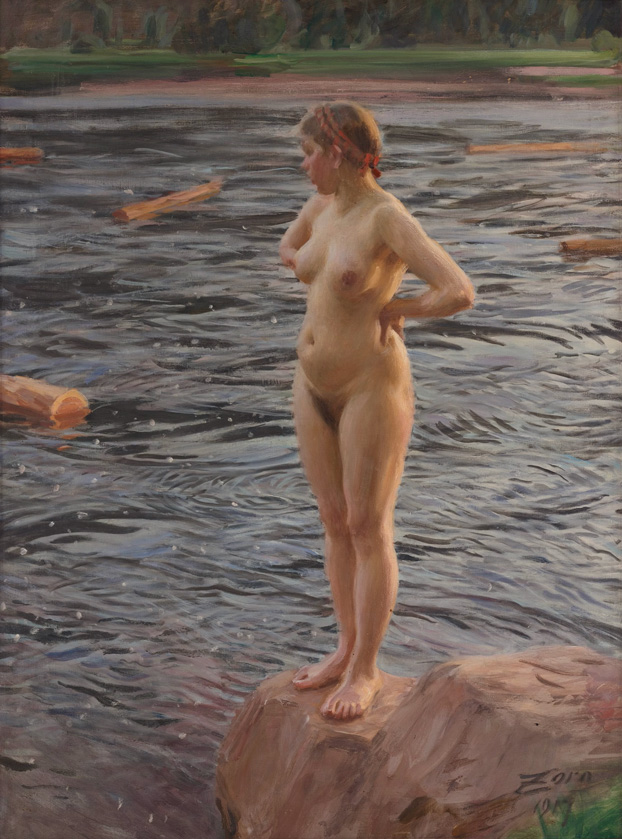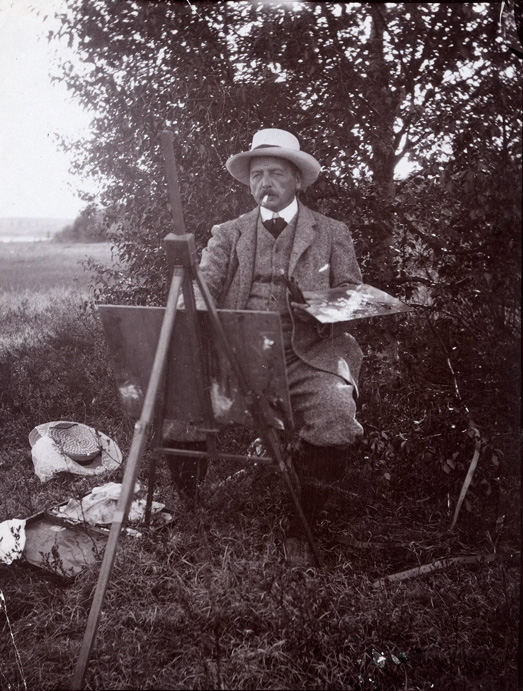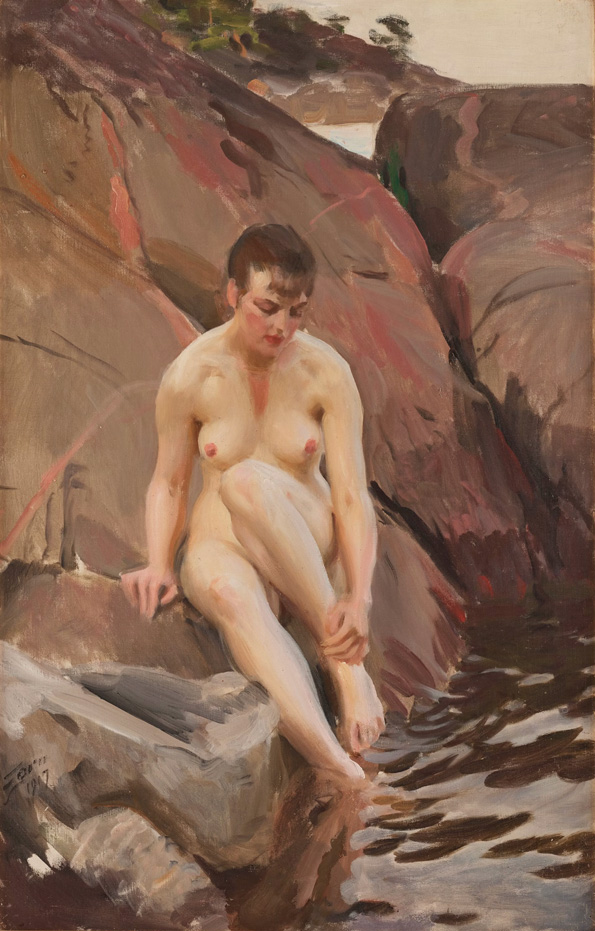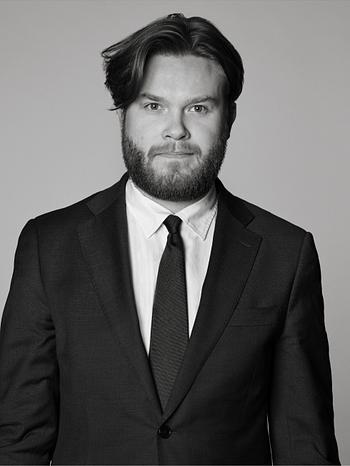Important Winter Sale presents three masterpieces by Anders Zorn
"Flottar Maja"
In the sensual composition "Flottar Maja," Anders Zorn focuses on the model while demonstrating his masterful technique in depicting how natural light reflects on the different surfaces in the motif.
The sun's rays envelop the model's soft body, while reflecting off the swirls of the water's surface, the hard stone and the rough barked logs. As a counterbalance to the dancing movement of the water, "Flottar Maja" stands firmly on the boulder with the red headband of the traditional Mora dress shining in her hair. With her arms at her sides, she watches the lively journey of the timber along the Dalälven river.
The location is carefully chosen. Already in the early 1900s, Zorn had started to long for his own fishing cottage, and he chose the spot opposite the majestic Gobsberget in Dalarna. Here, Gopsmorsstugan was built among towering firs and spruces, a lovely spring-fed brook, and on the other side, the flowing Dalälven.
Zorn often returned to Gopsmor, and at times he also received visitors there: the member of the Swedish Academy Karlfeldt stayed overnight on one occasion, and Bruno Liljefors traveled there to have his portrait painted in the winter-white forest. Life at Gopsmor was primitive, and the simple diet consisted mainly of herring, potatoes, and porridge. Although some of Zorn's guests found the conditions a bit too Spartan, there is no mistaking how the stays positively influenced Zorn's creativity and inspiration. Zorn always worked diligently at Gopsmor; it was as if an extra enthusiasm and joy of work came over him as soon as he managed to make his way to the secluded studio. In winter, he mostly worked in January, and in summer, just before Midsummer. His models were depicted in the glow of the studio's fire or engaged in some outdoor activity.

Zorn's biographer Gerda Boëthius writes the following in "ZORN. The Draughtsman, Painter, Etcher, Sculptor," 1949:
"When it came to nudes in the forest and, in general, greenery and inland nature, Gopsmor dominated. The large outdoor studio offered unexpected possibilities. Painters who visited Gopsmor often marveled at the ingenious choice of location. It is not only that nature offers such rich variation within a relatively limited area, but its entire composition is such that it provides an infinite variation of lighting, dawns, and colors. The surface of the river can have all colors from golden brown to clear blue, and the reflections from the water's surface affect the colors and light in the forest and meadows. Motifs were truly everywhere, as well as material for new ideas about light and color."
"Flottar Maja" was executed in this inspiring location in 1917. It is an exquisite example of Anders Zorn's finest painting, where models in the open air are combined with refined depictions of the surrounding landscape.
The composition bears similarities to other well-known works by Zorn from this period, such as "Gopsberget" (oil on canvas, 120 x 90 cm, 1915) and "Timret går" (oil on canvas, 120 x 98 cm, 1916), where Zorn also portrays the models in the foreground alongside advanced interpretations of flowing water.
To be sold at Important Winter Sale
Estimate 5 000 000 - 7 000 000 SEK

>Zorn as an outdoor painter, circa 1908. Photographer unknown, Zornmuseet ZFO0567.
"Märta"
In the late 1880s, during his summer visits to Dalarö, Anders Zorn began to depict the naked female body in the sunny archipelago landscape. He came back to this theme, sometimes referred to as "naket i det fria" (nude in the open air), throughout the rest of his career and brought him great success and fame. Around the year 1910, Gerda Boëthius suggests that one can see a revival in Zorn's paintings. She believes that during this time, you can see "a new phase where both subject matter and painting have something new, and the color has acquired a special tone with a preference for pink. In his archipelago paintings, he returned with affection to the subjects of his youth, where water and cliffs are the environment. [...] He filled the canvas with finely distributed tones, planes, values, and form, so that one can 'read his paintings' like a musician reads a score. His color palette is sometimes even more puritanical than in his youth. He often creates lighting effects with scraping or extremely thin paint."
The cosmopolitan Zorn moved far beyond the country's borders and was by no means limited to staying in either Mora or the archipelago. However, this was to change with the outbreak of the First World War. The new global situation led to disruptions in the artist's international relations, which had a significant impact on his life as he became increasingly settled in Mora. The year was now divided with a greater regularity between Mora/Gopsmor, Stockholm, and the archipelago.

In the following years, Zorn executed a series of nude studies against a picturesque backdrop of water and cliffs. Despite the breakthrough of "modern" art and occasional criticism, Zorn could take pleasure in presenting himself to the broader public as a national painter. Zorn's subjects remained in high demand, and collectors and buyers continued to eagerly await his works. Boëthius writes: "Both 1917 and 1918 were good years for work, and although he was criticized by the 'modern' group, he had the joy of being repeatedly encouraged by other comrades, whom he held in high esteem. On November 1, 1918, Carl Larsson wrote: 'If my admiration for you, Anders, could increase, it has done so since I saw your latest works...'."
"Märta" was painted in 1917 and was previously part of Consul Helge Ax:son Johnson's significant collection of Anders Zorn's paintings. In Ax:son Johnson's impressive residence, Berga Castle, the painting was placed in the consul's study along with two other Zorn motifs from 1917: "Werners eka" and "Helga."
To be sold at Important Winter Sale
Estimate 2 500 000 - 3 000 000 SEK

"Loftsängen"
"Loftsängen" from 1919 is an example of what is often referred to as Anders Zorn's ultima maniera – his last style. In his paintings from the early 20th century onwards, Zorn discovered a new mode of expression in which one can discern the continuation of his broad brushstrokes and the reduced sharpness of contours from his previous periods. However, one also perceives a fresh simplicity, characterized by a more concentrated color palette and a greater degree of formal restraint.
In the painting, we see the young Mora girl sitting naked on the loft bed, her gaze turned to the side, and her clothes collected on the floor to her left. Zorn and his wife Emma had permanently settled in the artist's hometown of Mora in 1896 and had become avid advocates of the local culture, aiming to make the Dalarna regional culture a national concern. In the early years of the 20th century, he began to depict the naked Mora girl in various interiors. Zorn enjoyed painting them in the timber cabins he owned in the town, effectively portraying the simple local life he advocated for.
Zorn's several paintings of the naked Mora girls can be seen as a development of his archipelago motifs, which had brought him great success since the late 1880s. In the summer of 1888, he began depicting scenes with the nude female body in the sunny archipelago environment, and he returned to the theme many times throughout his career. During his early years at the Royal Academy of Fine Arts, he had the opportunity to study the human nude, and he was also familiar with the centuries-old artistic tradition of the naked woman in nature.
To be sold at Important Winter Sale
Estimate 4 000 000 - 5 000 000 SEK

The works will be sold at Important Winter Sale
Viewing November 30th – December 5th, Berzelii Park 1, Stockholm
Open weekdays 11 am – 6 pm, weekends 11 am – 4 pm
Live AuctionDecember 6th – 8th, Arsenalsgatan 2, Stockholm
Read more about the auction and discover the full catalogue
*All works by Anders Zorn Important Winter Sale
Requests & condition reports Contact specialist

Tukholma
Lena Rydén
Johtava taideasiantuntija, moderni- ja 1800-luvun taide
+46 (0)707 78 35 71

Tukholma
Mark Sjöberg
Asiantuntija taide & taidegrafiikka
+46 (0) 707 88 84 72






























